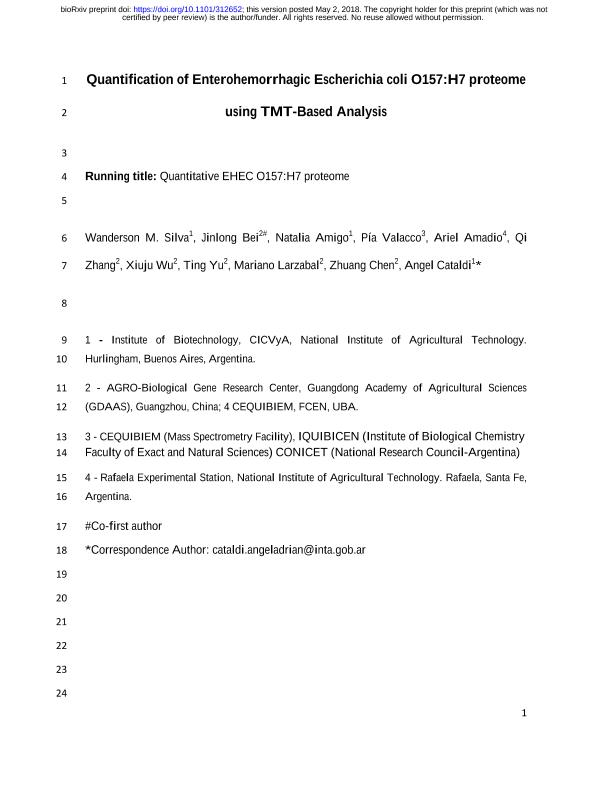Mostrar el registro sencillo del ítem
dc.contributor.author
Marques Da Silva, Wanderson

dc.contributor.author
Bei, Jinlong
dc.contributor.author
Amigo, Natalia

dc.contributor.author
Valacco, Maria Pia

dc.contributor.author
Amadio, Ariel
dc.contributor.author
Zhang, Qi
dc.contributor.author
Wu, Xiuju
dc.contributor.author
Yu, Ting
dc.contributor.author
Larzabal, Mariano

dc.contributor.author
Chen, Zhuang
dc.contributor.author
Cataldi, Angel Adrian

dc.date.available
2023-09-20T17:20:50Z
dc.date.issued
2018-05
dc.identifier.citation
Marques Da Silva, Wanderson; Bei, Jinlong; Amigo, Natalia; Valacco, Maria Pia; Amadio, Ariel; et al.; Quantification of Enterohemorrhagic Escherichia coli O157:H7 proteome using TMT-Based Analysis; Cold Spring Harbor Laboratory Press; BioRxiv; 5-2018; 1-35
dc.identifier.issn
2692-8205
dc.identifier.uri
http://hdl.handle.net/11336/212390
dc.description.abstract
Enterohemorrhagic Escherichia coli (EHEC) O157:H7 is a human pathogen responsible for diarrhea, hemorrhagic colitis and hemolytic uremic syndrome (HUS). EHEC infection is distributed worldwide and numerous outbreaks of diseases caused by enterohemorrhagic have been reported. To promote a comprehensive insight into the molecular basis of EHEC O157:H7 physiology and pathogenesis, the combined proteome of EHEC O157:H7 strains, Clade 8 and Clade 6 isolated from cattle in Argentina, and the standard EDL933 (clade 3) strain has been analyzed. TMT (Tandem Mass Tags)-based quantitative proteomic and emPAI analyses were performed to estimate the protein abundance in EHEC proteome. 2,234 non-redundant proteins of EHEC O157:H7 were identified. A comparison of this result with in silico data of EHEC O157:H7 genome showed that approximately 40% of the predicted proteome of this pathogen were covered. According to the emPAI analysis, 85 proteins were among the most abundant (e.g. GAPDH, FliC H-antigen, Enolase, and GroEL). Tellurite resistance proteins were also highly abundant. COG analysis showed that although most of the identified proteins are related to cellular metabolism, the majority of the most abundant proteins are associated with translation processes. A KEGG enrichment analysis revealed that Glycolysis / Gluconeogenesis was the most significant pathway. On the other hand, the less abundant detected proteins are those related to DNA processes, cell respiration and prophage. Among the proteins that composed the Type III Secretion System, the most abundant protein was EspA. Altogether, the results show a subset of important proteins that contribute to physiology and pathogenicity of EHEC O157:H7.IMPORTANCE The study of the abundance of proteins present within a complex mixture of proteins in a cell, under different conditions, can provide important information about the activities of individual protein components and protein networks that are cornerstones for the comprehension of physiological adaptations in response to biological demands promoted by environmental changes. We generated a comprehensive and accurate quantitative list of EHEC O157:H7 proteome, which provides a description of the most abundant proteins produced by this pathogen that were related to physiology and pathogenesis of EHEC. This study provides information and extends the understanding on functional genomics and the biology of this pathogen.
dc.format
application/pdf
dc.language.iso
eng
dc.publisher
Cold Spring Harbor Laboratory Press

dc.rights
info:eu-repo/semantics/openAccess
dc.rights.uri
https://creativecommons.org/licenses/by-nc-sa/2.5/ar/
dc.subject
EHEC
dc.subject
PROTEOMIC
dc.subject
SECRETION
dc.subject
QUANTIFICATION
dc.subject.classification
Bioquímica y Biología Molecular

dc.subject.classification
Ciencias Biológicas

dc.subject.classification
CIENCIAS NATURALES Y EXACTAS

dc.title
Quantification of Enterohemorrhagic Escherichia coli O157:H7 proteome using TMT-Based Analysis
dc.type
info:eu-repo/semantics/article
dc.type
info:ar-repo/semantics/artículo
dc.type
info:eu-repo/semantics/publishedVersion
dc.date.updated
2023-09-18T13:26:43Z
dc.journal.pagination
1-35
dc.journal.pais
Estados Unidos

dc.description.fil
Fil: Marques Da Silva, Wanderson. Instituto Nacional de Tecnología Agropecuaria. Centro de Investigación en Ciencias Veterinarias y Agronómicas. Instituto de Biotecnología; Argentina. Consejo Nacional de Investigaciones Científicas y Técnicas; Argentina
dc.description.fil
Fil: Bei, Jinlong. No especifíca;
dc.description.fil
Fil: Amigo, Natalia. Consejo Nacional de Investigaciones Científicas y Técnicas; Argentina. Instituto Nacional de Tecnología Agropecuaria. Centro de Investigación en Ciencias Veterinarias y Agronómicas. Instituto de Biotecnología; Argentina
dc.description.fil
Fil: Valacco, Maria Pia. Consejo Nacional de Investigaciones Científicas y Técnicas; Argentina. Instituto Nacional de Tecnología Agropecuaria. Centro de Investigación en Ciencias Veterinarias y Agronómicas. Instituto de Biotecnología; Argentina
dc.description.fil
Fil: Amadio, Ariel. Instituto Nacional de Tecnología Agropecuaria. Centro Regional Santa Fe. Estación Experimental Agropecuaria Rafaela; Argentina
dc.description.fil
Fil: Zhang, Qi. No especifíca;
dc.description.fil
Fil: Wu, Xiuju. No especifíca;
dc.description.fil
Fil: Yu, Ting. No especifíca;
dc.description.fil
Fil: Larzabal, Mariano. Consejo Nacional de Investigaciones Científicas y Técnicas; Argentina
dc.description.fil
Fil: Chen, Zhuang. No especifíca;
dc.description.fil
Fil: Cataldi, Angel Adrian. Instituto Nacional de Tecnología Agropecuaria. Centro de Investigación en Ciencias Veterinarias y Agronómicas. Instituto de Biotecnología; Argentina. Consejo Nacional de Investigaciones Científicas y Técnicas; Argentina
dc.journal.title
BioRxiv
dc.relation.alternativeid
info:eu-repo/semantics/altIdentifier/doi/https://doi.org/10.1101/312652
Archivos asociados
